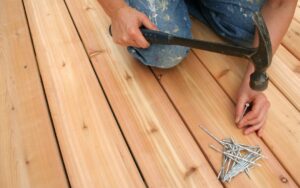The best way to keep deck repair costs down is to spot problems before they get out of hand. A professional can help you inspect your deck for damage and recommend the right action. For more information visit Deck Cleaning Summerville SC.
Examine wood for splinters and cracks that can cause rot. Tap on loose boards with a screwdriver to see how the wood feels and sounds. Any areas that feel soft or spongy should be removed and replaced.

The cracks that form in your deck’s boards aren’t only unsightly, but they can also create tripping hazards. The good news is that this problem can usually be repaired with a little time and effort. Cracks in wood are caused by a variety of environmental factors, including moisture and temperature fluctuations. This can lead to the expansion and contraction of the wood, which causes it to split.
The type of wood used is another factor, with some species more prone to cracking than others. Hardwoods like Ipe, Cumaru, and Tigerwood are less prone to this issue than softer woods like pine or pressure-treated lumber. In addition, the way the board is installed can contribute to cracking. For example, boards that aren’t spaced properly can cause stress that leads to cracking.
If the cracks are on the surface of the wood, you can usually fix them with a deck filler. You can find wood fillers at your local hardware store in both powdered and stick form. Look for a stainable filler that will take on the color of your wood and blend in with it. For deeper cracks, try using a wood putty or epoxy. However, if the crack is a structural concern, it’s a good idea to bring in a professional.
A professional can inspect the cracks and determine if they are simply cosmetic or a sign of a bigger issue. In addition to evaluating the length and width of the crack, they will check for any areas where the cracks are forming around metal fasteners or connections. Cracks that form around notches are especially concerning, as they can indicate a connection failure and may require the replacement of the entire board.
Taking the proper steps to prevent the appearance of cracks in your deck can save you money and extend the life of your wooden deck. The most important step is to ensure the boards are properly sealed and maintained, which will help protect them from absorbing excess moisture. You can also prevent cracking by purchasing higher-grade lumber that has a lower tendency to check and by installing the boards correctly.
A noticeable sag in a deck stair can result from structural problems or weather changes. Stairs comprise treads and risers, which slot into pockets in stair stringers (the inclined boards that carry the stairs). Treads and risers may also be fastened with nails, but the best way to repair a loose stair is to replace it. If a stair is still firm, add wood shims between it and the frame to prevent it from pulling away from the deck.
Treads and risers are usually held firm and squeak-free by wedges glued and nailed to both sides. Creaking is often caused by the movement of these wedges, which can be silenced by simply removing them and regluing them to both the tread and the riser. If the wedges are in good shape, you can coat them with modern resin glue and hammer them tightly.
The stair framing is a complicated piece of joinery, and if the stairs are loose, it’s essential to take them apart carefully to ensure that they’re reassembled properly. It’s also important to ensure that the stair is not sitting on the floor, which can cause it to buckle and warp over time.
Before attempting to work on a sagging stair, blow compressed air into any spaces beneath the stairs to clear them of dust and debris. You can then begin to pry the risers and treads free from the stringers, being careful not to damage them. A hammer and screwdriver should be enough to break any glue or nail holding the riser or tread in place.
Once the stair is completely disassembled, you can see where the problem lies. Most squeaks come from the front of a stair, so it’s a good idea to drill holes at opposing angles through the tread and into the riser. This will squish the wood together and silence any squeaks.
You can use a countersink tool to make the hole bigger, allowing you to use longer screws that are more likely to hold the wood in place. You can also shim the staircase by installing 2x material glued and screwed between the stringers to apply inward pressure to the stairs. This will keep the treads and risers from working outward, but it’s a complex job that should be left to professionals.
A loose or wobbly handrail can be a serious safety hazard, especially for older adults and people with mobility issues. This can cause falls that result in injury or even death. Fortunately, most loose deck rails can be repaired easily with some simple DIY steps.
Checking that the posts and beams that support the railing are firmly fastened is usually all it takes to fix a loose wood deck rail. Most problems stem from a bad connection between the post and the deck frame or joists. At the very least, lag screws or bolts should be used to connect the framing to the post, and those should be surrounded with blocking to keep them in place. Bolts and screws should be tightened, and lags checked periodically to ensure they’re still secure.
For metal railings, check the connections between each baluster and the newel post. Loose balusters are typically caused by the screw or nail used to hold the railing to the post, which has worked loose over time as it’s bowed from use. If the bolt or screw remains intact, it can be tapped with a hammer. Then the railing can be re-secured with a fresh screw or nail.
If the newel posts feel solid, but the fence still wiggles, check the metal hardware that holds it together. This hardware usually has holes (sometimes plugged) under the surface that permit tightening by turning a star-shaped nut on the end of a tool. If these bolts are loosened, it can cause the wooden handrail to move between the newel posts.
It’s important to install deck framing components according to the building code and manufacturer’s instructions. However, it’s rare for framing errors to be the sole cause of a loose deck railing. A loose or missing railing is more likely to occur because of an improper design or installation. If a visitor to your deck falls and is injured by a faulty or loose handrail, you could be liable under premises liability laws. For this reason, it’s best to inspect and repair your deck for loose or broken handrails to prevent injuries.
When mold and mildew grow on your deck, it’s more than an eyesore. The fungi can damage wood and, if left unchecked, will cause structural problems. Mildew and mold grow in the wettest parts of your deck and are often found on surfaces that trap moisture. While both can damage wood, mildew is not as invasive and generally doesn’t penetrate the wood grain as mold.
Luckily, if you catch these problems early, mold and mildew don’t cause much damage. If you spot it on your deck, take action right away. However, the method you use to remove the spores and roots will vary depending on the severity of the problem.
For mildew, you can scrub the affected area with a brush and a cleaning solution made from white distilled vinegar. The vinegar will remove the spores and prevent them from growing back.
If the mold is bad, you may need to pressure clean the deck. Use a low setting or hire a professional to avoid damaging the soft wood.
You can also use an oxygen bleach solution to remove mildew from your deck. Add 8 to 10 tablespoons of trisodium phosphate and one cup of household chlorine bleach to a gallon of water, then scrub the area with a nylon bristle brush. After cleaning, you can rinse off the area with a garden hose.
For more stubborn stains, you can use a power washer. Be careful not to overuse the nozzle, and follow the manufacturer’s instructions on the unit.
The best way to prevent these problems is to keep moisture off your deck. This can be done by improving drainage or moving potted plants around periodically. If you need to leave plants on your deck, ensure they have plenty of space and are supported by pot feet to improve air circulation. You can also install a drip system to divert moisture from the wood. This will stop the rot before it starts. This is important for any wooden deck, whether covered or not.
